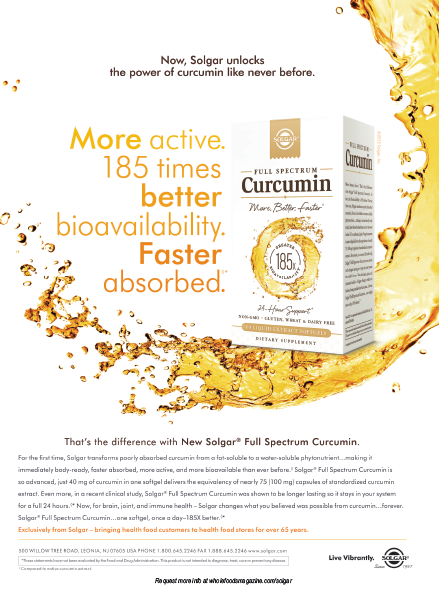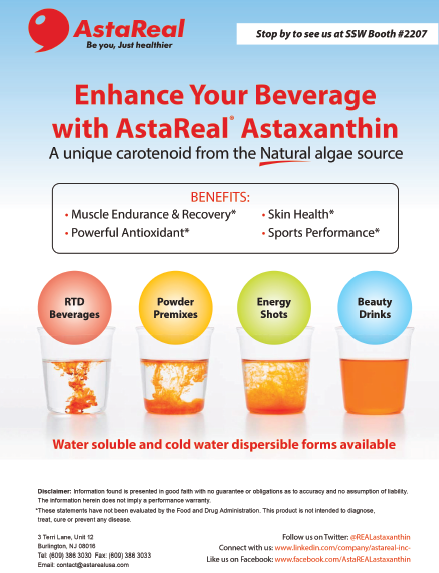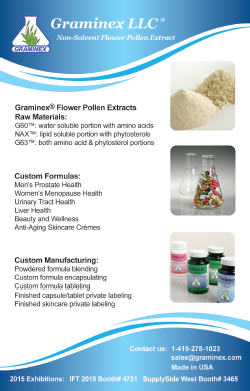When dietary supplement newcomers are looking for a starting point, one of the first supplements they may think of is omegas. These healthy fats support a variety of functions in the heart, brain and eyes, and scientific studies are beginning to link balanced levels of omegas to many other health functions as well. However, due to a lack of certain omegas in the traditional Western diet, levels can often be imbalanced—and supplements can help fill this nutritional gap. Many omega supplements on the market use marine sources, like Antarctic krill and cold-water fish. While scientific research has shown them to be effective, the plant world also boasts omega sources that simultaneously offer other health benefits. Make sure your shoppers know about some of these plant-based omegas as well before they reach for the shelf.
Know Your Omegas
In previous coverage of omegas, we’ve often mentioned eicosapenta enoic acid (EPA) and docosahexaenoic acid (DHA). These polyunsaturated fats (PUFAs) are commonly researched omegas in supplemental form, but plant-based omegas primarily offer a different form. Herb Joiner-Bey, N.D., medical science consultant at Barlean’s Organic Oils, Ferndale, WA, explains, “Alpha-linolenic acid (ALA), the plant omega-3, is the parent compound of the omega-3 family of polyunsaturated fatty acids. ALA is found in phytoplankton in the ocean and in green leaves of plants on land.” When humans and animals consume these plant sources, the body breaks down ALA into EPA and DHA as needed. There is some controversy regarding the efficiency of this conversion—keep this in mind for later.
enoic acid (EPA) and docosahexaenoic acid (DHA). These polyunsaturated fats (PUFAs) are commonly researched omegas in supplemental form, but plant-based omegas primarily offer a different form. Herb Joiner-Bey, N.D., medical science consultant at Barlean’s Organic Oils, Ferndale, WA, explains, “Alpha-linolenic acid (ALA), the plant omega-3, is the parent compound of the omega-3 family of polyunsaturated fatty acids. ALA is found in phytoplankton in the ocean and in green leaves of plants on land.” When humans and animals consume these plant sources, the body breaks down ALA into EPA and DHA as needed. There is some controversy regarding the efficiency of this conversion—keep this in mind for later.
Since ALA, EPA and DHA are so well intertwined, some shoppers may not understand why they should seek out plant-based omega sources over marine, outside of consumers like vegans who do not consume fish. As it turns out, there are many things to consider. James Liu, founder, and Maureen Wurster, marketing/PR coordinator at SeabuckWonders, Chicago, IL, point out a “huge advantage that plant-based omegas have is that they usually need far less processing than marine sources.”
Author, educator and formulator Udo Erasmus, who partnered with Flora Manufacturing and Distributing, Lynden, WA, to create the Udo’s Choice health product line, goes into detail on how processing causes some issues for marine-sourced omegas. “Omega-3 derivatives (EPA and DHA) are five times even more sensitive to damage than essential omega-3 ALA,” he says.
In addition to being more rapidly damaged, fish oils undergo further steps to improve palatability and ensure purity, which can further minimize potential nutritional content. Since many plant-based omega sources don’t have this issue, Liu and Wurster explain that this “means plant-based oils are more self-stable and less prone to spoiling. That’s one of the reasons plant based oils typically taste better, too.”
 It’s important to realize that many marine oil supplements are perfectly viable—but due to some of these issues, it’s imperative that you seek out transparent manufacturers and suppliers to make sure those are the type of supplements you are stocking in your store.
It’s important to realize that many marine oil supplements are perfectly viable—but due to some of these issues, it’s imperative that you seek out transparent manufacturers and suppliers to make sure those are the type of supplements you are stocking in your store.
Dallas Clouatre, Ph.D., consultant for R&D at Jarrow Formulas, Inc. Los Angeles, CA, says contamination concerns may be another reason to think of plant-based omegas. While this isn’t a guaranteed issue for every marine source, consumers may be wary of “the various toxins that modern industrial and agricultural practices dump into the oceans, including pesticides, PCBs, heavy metals and other such compounds.”
Mike Fata, CEO and co-founder of Manitoba Harvest Hemp Foods, Winnipeg, Manitoba, Canada, adds that due to these type of concerns, “plant-based omegas offer the option of certified organic and non-GMO.” Organic certification in particular can be hard to come by for marine sources.
Sustainability may be another selling point. Though marine oil makers have made strides in improving sustainability issues, Rally Ralston, managing partner of Salba Smart, Denver, CO, believes that “plant-based products will always have an edge on sustainability initiatives.” This is simply due to the fact that plant sources will by nature lend themselves to more organized and sustainable farming practices than fish sources. Erasmus adds that so long as healthy soil is maintained, sustainable plant farming will always be a possibility, while marine sources may have concerns such as overfishing. These concerns aren’t omnipresent for marine, for example, Clouatre explains that krill as a source isn’t really at risk from overfishing, though pollution still remains a concern.
|
Select Plant-Based Omegas Products Barlean’s Organic Oils: Barlean’s Organic High-Lignan Flaxseed Oil, Barlean’s Organic Flaxseed Oil, Barlean’s Flaxseed Oil Omega Swirl, Barlean’s Total Omega Vegan, Barlean’s Vegan Swirl. Bluebonnet Nutrition Corp.: Bluebonnet’s Natural Omega-3 Vegetarian DHA, Bluebonnet’s Early Promise Prenatal Gentle DHA 100 and 200 mg Vegetarian Softgels, Bluebonnet’s Certified Organic Flax Seed Oil 1000 mg Softgels, Bluebonnet’s Evening Primrose Oil 500 mg Softgels, Bluebonnet’s Evening Primrose Oil 1300 mg Softgels, Bluebonnet’s Omega-3-6-9 1000 mg Softgels. CannaVest Corp.: PlusCBD Oil Balm, PlusCBDOil Capsules, PlusCBDOil 1 oz. and 2 oz. Spray, PlusCBDOil Concentrates Total Plant Complex, PlusCBDOil Concentrates Gold Formula. Flora Manufacturing and Distributing: Flora Flax Oil, Udo’s Choice 3,6,9 Blend, Udo’s Choice 3,6,9 High Lignan Blend, Udo’s Choice 3,6,9 DHA (from algae) Blend. Jarrow Formulas, Inc.: Omega Nutrition’s Hi-Lignan Flax Oil. Mamma Chia: Vitality Beverages, Chia Squeeze Vitality Snacks, Chia Granola Clusters, Chia Vitality Bars, Clean Energy Beverages and the Chia & Greens Beverage. Black and white organic chia seeds are also available. Manitoba Harvest Hemp Foods: Hemp Hearts raw shelled hemp seeds, Hemp Heart Bites, Hemp Oil, Hemp Pro protein powders. Salba Smart: Salba chia. SeabuckWonders: Omega-7 Complete, Sea Buckthorn Seed Oil Caps and Droppers, Sea Buckthorn Berry Oil Dropper Bottle, Ultimate Hair, Skin and Nails. |
Picking Your Plants
We’ve established why shoppers may want to add plant sources to their omegas rotation, but which ones should you stock? Like their marine counterparts, there are several options. Joiner-Bey names flaxseed oil as “the most commercially abundant source of plant ALA.” He notes that flaxseed “produced in the cold climates of the north central states of the Union, such as North Dakota, and south central Canada” provide especially omegas-rich oil, with one tablespoon providing at least 6,000 mg of ALA to work with.
In addition to high omegas content, flaxseed oil contains many other nutrients that support multiple facets of health. Trisha Sugarek MacDonald, BS, MS, senior director of research and development and national educator at Bluebonnet Nutrition Corporation, Sugar Land, TX, says that flaxseed and flaxseed oil are “known to be a naturally rich source of magnesium, potassium, B vitamins, protein and zinc. They are also known to be low in saturated fatty acids, calories and furthermore, contain no cholesterol—making them beneficial for heart health.”
While Erasmus points out that the bulk of omegas research revolves around marine sources, as “the fish oil industry is several hundred years old, whereas ALA only began to attract interest after 1980,” there is still promising scientific evidence coming out about flaxseed’s potential benefits. In one study that focused on flaxseed and high blood pressure, 110 participants with peripheral arterial disease were either given 30 g of milled flaxseed or a placebo daily over the course of six months. While the flaxseed group “exhibited significant reductions in systolic (–10 mm Hg) and diastolic (–7 mm Hg) blood pressure,” according to the study authors, the exact hypertensive mechanisms were unclear (1). Another systematic review of trials, also on flaxseed and high blood pressure, corroborated these results, with the study data suggesting that consuming flaxseed as a whole seed for a duration longer than 12 weeks helps yield optimum results (2).
Janie Hoffman, founder and CEO of Mamma Chia, Carlsbad, CA, names chia as a great source of omegas due to its nutritional content and versatility. Along with high omega content, she names “protein, fiber, antioxidants, calcium and other nutrients” as reasons why chia may be an ideal option. She also mentions that their flavor profile is easily incorporated into meals, so the processing for palatability that some fish oils require is not necessary.
Variants of chia seeds should also be on your radar. Salba chia, an heirloom, branded version of the chia seed, makes for “a high source of fiber and a good source of calcium, magnesium and copper as well as 3 grams of complete protein per 15 gram serving,” says Ralston. In one study, rats that had previously been eating a high-fat, high-carbohydrate diet were given chia seeds over the course of eight weeks, with the high levels of ALA present in chia one of the main focuses for the administrators. At the conclusion of the study, the rats showed improved insulin sensitivity and glucose tolerance, reduced visceral adiposity, decreased hepatic steatosis and reduced cardiac and hepatic inflammation and fibrosis without changes in plasma lipids or blood pressure. Lipid redistribution with lipid trafficking away from the visceral fat and liver was also recorded (3).
Dinner Detour
Flax and chia may seem like elements you would associate with what’s on your plate over supplements, but that doesn’t detract from the benefits of these superfoods. In fact, this plays into another positive asset of plant-based omegas: easier integration into food products. Hoffman notes that in the case of chia, “grinding, fermenting and cooking aren’t necessary, and chia can easily be incorporated into any recipe adding loads of nutrition to any meal or snack.” Her company offers both snacks and beverages made with chia.
 Many vegetables can serve as sources of omega-3s as well. Clouatre names cauliflower, broccoli, bok choy and brussels sprouts as some of the best options. Certain legumes, like mung beans, navy beans and kidney beans, offer balanced ratios of omega-6s and omega-3s as well, though he cautions that they are “not particularly high in fatty acids overall.” The omega-6 to omega-3 ratio is important for health, though it can sometimes be missed when it comes to the dietary discussion. Erasmus recommends a 2:1 ratio of omega-3 to omega-6, but says that due to imbalance in the Western diet, ratios of 1:15 to 1:20 can often be seen. The reason these ratios are so important, he explains, is that “omega-3 and omega-6 compete for the same conversion enzymes in the body and too much of one crowds out the other.”
Many vegetables can serve as sources of omega-3s as well. Clouatre names cauliflower, broccoli, bok choy and brussels sprouts as some of the best options. Certain legumes, like mung beans, navy beans and kidney beans, offer balanced ratios of omega-6s and omega-3s as well, though he cautions that they are “not particularly high in fatty acids overall.” The omega-6 to omega-3 ratio is important for health, though it can sometimes be missed when it comes to the dietary discussion. Erasmus recommends a 2:1 ratio of omega-3 to omega-6, but says that due to imbalance in the Western diet, ratios of 1:15 to 1:20 can often be seen. The reason these ratios are so important, he explains, is that “omega-3 and omega-6 compete for the same conversion enzymes in the body and too much of one crowds out the other.”
Healthy levels of ALA from a diet have some scientific evidence for support in certain health areas. Hoffman mentions a study using data from the Nurses Health Study that correlated higher amounts of dietary ALA with lowered risk of ischemic heart disease. The study authors noted that other foods with high contents of polyunsaturated fats may have similar effects as well (4). A similar study profiling the Indo-Mediterranean diet, also high in ALA, had similar findings.
Branching Out
While these may be some of the most common plant-based omegas available, there are still several other plant sources to consider. Liu and Wurster are proponents of sea buckthorn, saying that what “makes it so special is that you can get four different kinds of fatty acids from one plant including omegas-3 and 7, as well as loads of other vitamins and nutrients.” Omega-7, which can be difficult to find in supplements, is believed to support cell membranes, provide anti-inflammatory properties and positively affect blood insulin levels (5). Some may be wary of sea buckthorn due to the presence of palmitic acid, a saturated fat, but Liu and Wurster explain, “there is simply not enough palmitic acid in sea buckthorn oil to do any harm.” In addition to being used as an internal supplement, sea buckthorn has also found popular use in the skincare arena.
In one study focusing on dry eye support, 86 patients ranging from 20 to 75 years old, all with dry eye symptoms, were supplemented with oral sea buckthorn oil or a placebo daily over a two-month period, with clinical dry eye tests and symptom follow-ups being performed. Study results showed that tear film hyperosmolarity, a focal factor in dry eye, increased overall in both groups, but significantly less in the sea buckthorn group compared to placebo. Maximum intensities of redness and burning were lower overall in the sea buckthorn group as well (6).
Sugarek MacDonald adds other options like primrose oil and borage oil to the list of plant sources to consider. Her company offers softgels using these ingredients that provide a wide array of omegas content; along with some previously mentioned fatty acids like omega-6 and linoleic acid, gamma linolenic acid (GLA), as well as omega-9 fatty acid and oleic acid are present. GLA in particular is a valuable omega because it produces PGE-1, a prostaglandin. “PGE-1 inhibits inflammation in the body by knocking out COX-2, an enzyme involved in the inflammation pathway,” she explains. Certain demographics may also want to look out for certain omegas as well. Sugarek MacDonald recommends primrose oil for women with premenstrual syndrome, as they may have deficiencies in GLA.
 Black currant also is a potential source of GLA, along with high omega-6 content. In one study, patients in intensive care units recorded sizable increases in dihomo-gamma-linolenic fatty acid (DGLA) and EPA levels when supplemented with black currant oil (7). Results from another study in rats suggested that black currant oil may have positive effects on lipid metabolism in the liver as well (8).
Black currant also is a potential source of GLA, along with high omega-6 content. In one study, patients in intensive care units recorded sizable increases in dihomo-gamma-linolenic fatty acid (DGLA) and EPA levels when supplemented with black currant oil (7). Results from another study in rats suggested that black currant oil may have positive effects on lipid metabolism in the liver as well (8).
One plant that is trending upwards in a big way is hemp. Fata explains that part of the appeal is the fact that the “omega-6 to omega-3 ratio in hemp is how nature intended. Hemp foods have a broad range of omegas—short and long-chain fatty acids, that are suitable for daily and long-term consumption.” Hemp is also a source of the ever-valuable GLA, he adds.
Similar to chia, hemp is also very versatile in food, both as whole seeds, as well as oil. Hemp seeds can be sprinkled over “cereal, yogurt, salad, soup, or pretty much anything,” as well as used as a base for smoothies and sauces. While hemp oil can be drizzled over pasta or veggies, Fata recommends not using it to cook with due to a low heat threshold, running the risk of losing some of the important omegas content.
Stuart Tomc, vice president of CannaVest Corp., Las Vegas, NV, says that in addition to the “fatty acids, cannabinoids, terpenes, plant sterols and naturally occurring vitamin E” found in agricultural hemp extracts, hemp itself is well suited for sustainably minded-farming, as it “sequesters CO2, requires little water and requires no pesticides because after all, hemp is simply a weed.”
The scientific footprint as far as hemp goes still has room to grow, but initial studies look promising. One animal study showed that rats administered dietary hempseed over a 12-week period showed “significant cardioprotective effects” over a control group. The administrators of this study believed this to be due to hempseed’s PUFA content, which also showed increased levels in the hempseed group, specifically, ALA and GLA (9).
 The Conversion Question
The Conversion Question
As a precursor to the well-known EPA and DHA, it’s easy to see why ALA is the star nutrient in many of these plant-based omega choices, but some believe it may not be the ideal choice. They feel that during the conversion process in the body, a level of nutritional value is lost, sometimes to the point where these plant sources may still be applicable for a variety of other supplemental concerns, but not for omegas. While experts do acknowledge that this conversion takes place, they also say that the fears of plant-based omegas being ineffective are blown out of proportion.
Liu and Wurster note that “More studies are happening to further the understanding of how ALA works in the body,” due to fish oils and their components being dominant in the omegas space for so long. However, they believe that due to the rise of veganism as well as sustainability concerns, plant-based omegas will always have some use. As more studies on ALA develop, some interesting facts are being found. One study showed that vegans and non-fish eating individuals converted plant-based ALA to EPA and DHA at faster rates than fish eaters (10).
According to Clouatre, “there is a conversion issue and it should not be dismissed. However, it also can be surmounted by long-term planning.” The first part of his solution harkens back to the omega-6/omega-3 ratio, as an imbalance between the two “will actively interfere with the enzyme involved in converting ALA to EPA and DHA…these enzymes can become ‘saturated’ with omega-6s as they are required to convert short chain forms into longer chain forms.” The second part is time, particularly when discussing converting ALA to DHA. He mentions research that showed vegans needed to consume at least 3.7 g of ALA daily to significantly increase blood levels of EPA and DHA over a six-week period. At a 3 g dosage level, no changes in DHA levels were seen after three months, but they did increase after 10 months. Make sure your customers stick to a proper supplement regimen to ensure the best possible results. WF
Published in WholeFoods Magazine, October 2015
References
1. Caligiuri SP et.al, Flaxseed consumption reduces blood pressure in patients with hypertension by altering circulating oxylipins via an alpha-linolenic acid-induced inhibition of soluble epoxide hydrolase. Hypertension, 64(1):53-9, 2014.
2. Khalesi S et.al, Flaxseed consumption may reduce blood pressure: a systematic review and meta-analysis of controlled trials. J Nutr, 758-65, 145(4), 2015.
3. Poudyal H et.al, Lipid redistribution by a-linolenic acid-rich chia seed inhibits stearoyl-CoA desaturase-1 and induces cardiac and hepatic protection in diet-induced obese rats. The Journal of Nutritional Biochemistry, 23(2), pgs.153-162.
4. Hu FB et.al, Dietary intake of alpha-linolenic acid and risk of fatal ischemic heart disease among women. Am J Clin Nutr, 69(5):890-7, 1999.
5. SeabuckWonders, Frequently Asked Questions, http://www.seabuckwonders.com/faq/, accessed 8/21/2015.
6. Larmo PS et.al, Oral sea buckthorn oil attenuates tear film osmolarity and symptoms in individuals with dry eye. J Nutr., 140(8), 1462-8., 2010.
7. Diboune M et.al, Composition of phospholipid fatty acids in red blood cell membranes of patients in intensive care units: effects of different intakes of soybean oil, medium-chain triglycerides, and black-currant seed oil. JPEN J Parenter Enteral Nutr., 16(2):136-41, 1992
8. Vecera R et.al, Antioxidant status, lipoprotein profile and liver lipids in rats fed on high-cholesterol diet containing currant oil rich in n-3 and n-6 polyunsaturated fatty acids. Physiol Res., 52(2):177-87, 2003
9. Al-Khalifa A et.al, Effect of dietary hempseed intake on cardiac ischemia-reperfusion injury. Am J Physiol Regul Integr Comp Physiol., 292(3): R1198-203, 2007.
10. Welch AA et.al, Dietary intake and status of n-3 polyunsaturated fatty acids in a population of fish-eating and non-fish-eating meat-eaters, vegetarians, and vegans and the product-precursor ratio [corrected] of a-linolenic acid to long-chain n-3 polyunsaturated fatty acids: results from the EPIC-Norfolk cohort. Am J Clin Nutr., 92(5):1040-51, 2010.









